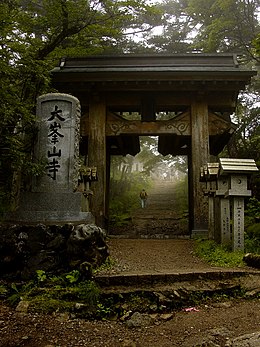Ōminesan-ji
| Ōminesan-ji | |
|---|---|
 Stairs on the way to Ōminesan-ji | |
| Religion | |
| Affiliation | Buddhist |
| Deity | Zaō-gongen |
| Rite | Shugendō |
| Location | |
| Location | Ōmine-san, Tenkawa-mura Yoshino-gun, Nara Prefecture |
| Country | Japan |
| Geographic coordinates | 34°15′11″N 135°56′29″E / 34.2530°N 135.9414°E |
| Architecture | |
| Founder | En no Gyōja |
| Completed | Second half of 7th century |
| Type | Cultural |
| Criteria | ii,iii, iv, vi |
| Designated | 2004 |
| Reference no. | 1142bis-001 |
Ōminesan-ji (
Overview
[edit]According to tradition, the temple was established in at the end of the 7th century by En no Gyōja, the founder of Shugendō, a form of mountain asceticism drawing from Buddhist and Shinto beliefs. The main hall is located near the summit of Sanjōgatake (1719.2 meters), located in the middle of the Ōmine Mountain Range, and enshrines Zaō Gongen. While the main hall (Zaō-dō) of Kinpusen-ji on Mount Yoshino is called "Sange no Zaō-dō," the main hall of Ōminesan-ji is called "Yamagami no Zaō-dō." The two Zaō-dō temples on the mountain and at the bottom of the mountain are more than 20 kilometers apart, and are now separate temples, but originally they were part of a single Shugendō temple called "Kinpusen-ji." It was only in modern times that they were separated.
"Kinpusen-san" and "Ōmine-san" do not refer to individual peaks, but to the mountains as a place of faith and training. "Kinpusen-san" refers to the entire sacred mountain area from Mount Yoshino to Sanjōgatake, and the group of temples scattered there was collectively called "Kinpusen-ji." On the other hand, "Ōminesan" is a general term for the mountains of the Ōmine mountain range, including Mt. Daifugen, Mt. Misen, Mt. Hakkyogatake, and Mt. Shakagatake. The 80-kilometer road from Mt. Yoshino through the Ōmine mountain range to Kumano Hongū Taisha in Tanabe, Wakayama is called the "Ōmine Okugake Trail" and is a training route for ascetic monks.
Much of the early history of Ōminesan-ji is unclear. In the Tenpyō era (729-749), Gyōki is said to have carried out a major renovation, and by some legends say built Kinpusen-ji at the foot of the mountain as the Zaō-dō Hall at the top of Ōminesan was difficult to access. Although the went into decline in the early Heian period, it was revived by the Shingon Buddhist monk Shōbō (Rigen Daishi) at the end of the 9th century, and since the 10th century, it has been visited by many members of the imperial family and aristocrats. Fujiwara no Michinaga offered sutras in a gilt bronze container in Heian period buried in a mound near the mountain top, which was excavated and designated a National Treasure in August 11, 2007 During the Sengoku period, the main hall was burned down in a conflict with the Ikko sect, but it was rebuilt in the Edo period. In 1614, Tokugawa Ieyasu ordered Tenkai, a Tendai Buddhist monk (the founder of Kan'ei-ji in Edo and other temples), to become head of Kinpusen-ji and Ōminesan-ji. After the Meiji restoration, the Shinbutsu Bunri abolished the syncretic Shinto-Buddhist beliefs that had been practiced throughout the country for many centuries, and Shugendō was officially suppressed. From 1871, the Meiji government declared Kinpusen-ji and Ōminesan-ji to be a Shinto shrine. In 1886, the Kinpusen-ji and Ōminesan-ji reverted to Buddhism, and the two locations were separated into Kinpusen-ji at the foot of the mountains and Ōminesan-ji at the top. In 2004, Ōminesan-ji was designated as part of a UNESCO World Heritage Site under the name Sacred Sites and Pilgrimage Routes in the Kii Mountain Range.
Precincts
[edit]There is a ridge path from Mount Yoshino to the main hall of Ōminesan-ji, but general worshippers climb Sanjōgatake from Dorogawa in Tenkawa Village at the foot of the mountain. It takes about four hours on foot from Dorogawa. Even from the trailhead, Ōmine Ōhashi Bridge, it takes about three hours to climb one way. The sanctuary around the Sanjōgatake peak (
Cultural properties
[edit]Important Cultural Properties
[edit]- Main Hall (Zaō-dō) - Rebuilt in 1691. It is a hipped-gabled building measuring approximately 23 x 19 meters and 13 meters high. Copper tiles and copper sheet roofing. The inner sanctuary was built in 1691, but the outer sanctuary was expanded in 1706.[6]
See also
[edit]- Sacred Sites and Pilgrimage Routes in the Kii Mountain Range
- Shugendō
- List of Historic Sites of Japan (Nara)
Notes and references
[edit]- ^ "
大峯山 寺 境内 " (in Japanese). Agency for Cultural Affairs. Retrieved 20 August 2024. - ^ .
- ^ Kaneko, Juri. "Nyonin kinsei no "dentō" to honshitsu" [The term "tradition" and essence of denying women] (PDF). Gendai shūkyō to josei [Modern religion and women] (in Japanese) (9). Tenri University. Retrieved 10 October 2017.
- ^ Rurubu, ed. (2004). Nihon hyakumeizan yamāruki gaido [100 Famous Mountains in Japan—Mountaineering Guide]. Otona no ensoku bukku (in Japanese). Vol. 2. JTB. ISBN 9784533052279. OCLC 169911259. Retrieved 10 October 2017.
- ^ "Ōmine, nyonin kekkai—nyonin kinsei no yama yottsu no mon (4)" [Four gates on a "No woman admitted" mountain; Ōmine, barriers against women (4)] (in Japanese). 25 April 2009. Retrieved 10 October 2017.
- ^ "
峰 山寺 本堂 " (in Japanese). Agency for Cultural Affairs. Retrieved 20 August 2024.
External links
[edit]- Sacred places and pilgrimage roads in Kii mountains –Yoshino, Ōmine area (in Japanese)
- Ōmine Okugake Training (in Japanese)


